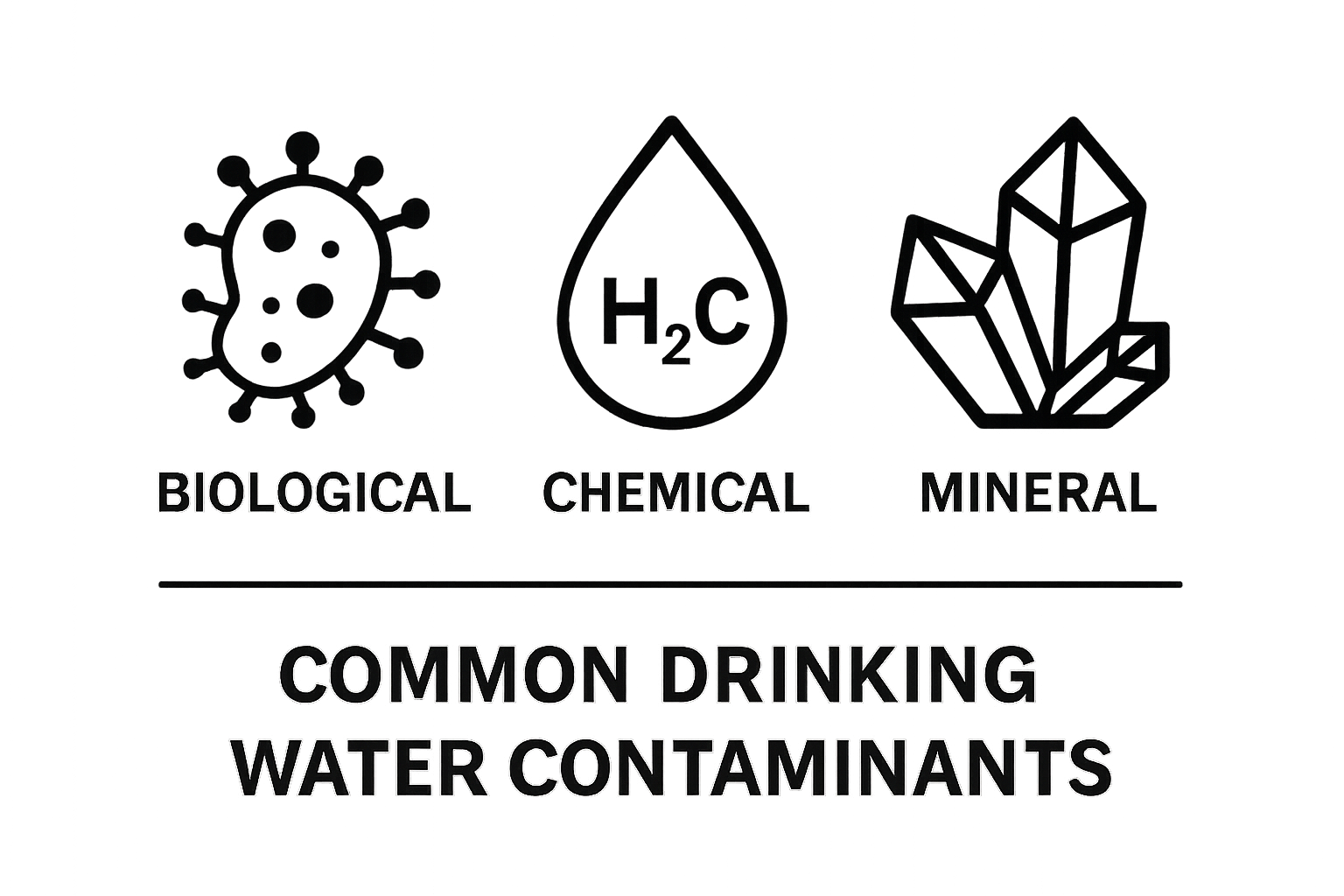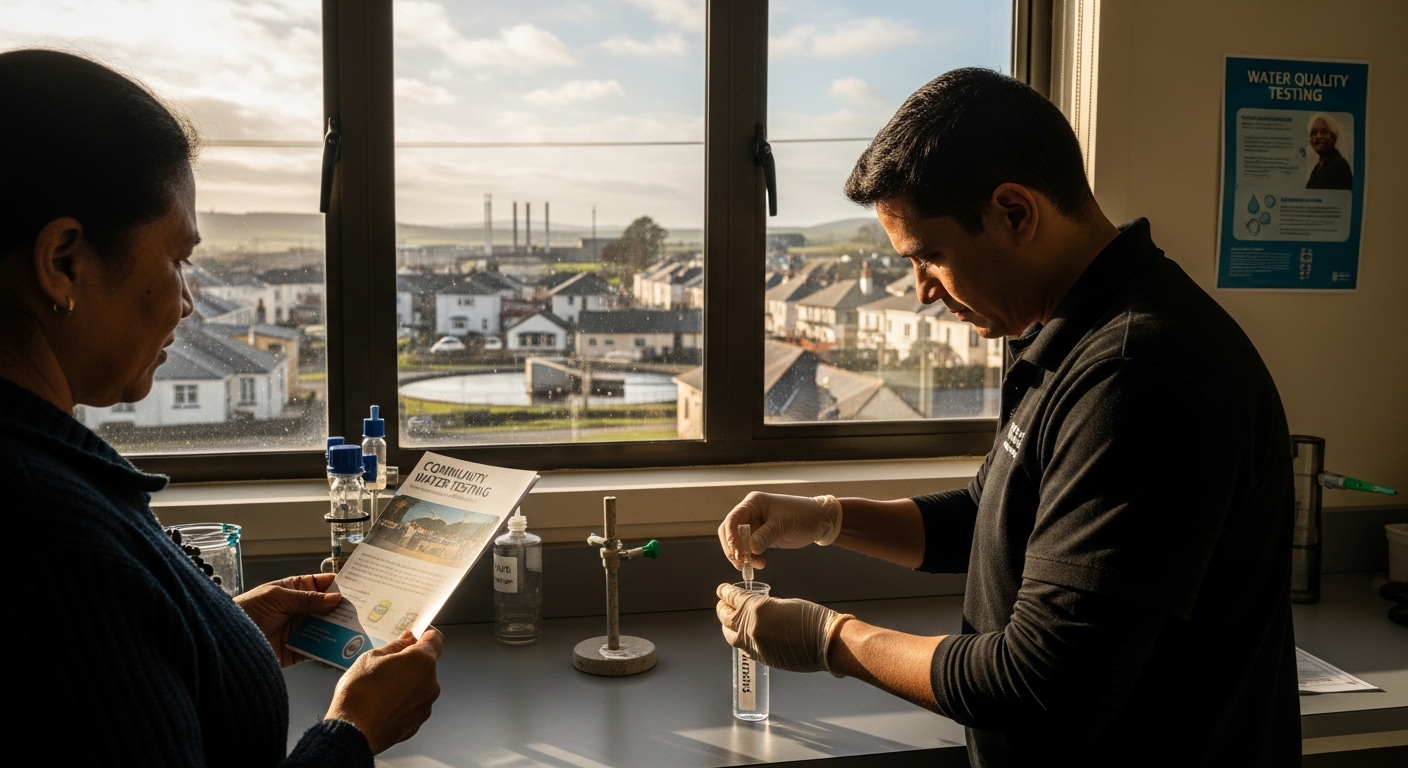Uncategorized
Understanding Why Test Drinking Water for Safety
Clean water looks safe but appearances can be deceiving. Studies found that millions of Americans are exposed to contaminants in their tap water every year. Most people think the real danger comes from rare disasters or old, rusty pipes but many invisible threats slip through even today’s modern systems. The real shock is how these tiny pollutants can quietly affect your health for years before you notice anything at all.
Table of Contents
- The Importance Of Water Quality For Health
- Common Contaminants Found In Drinking Water
- How Water Testing Works: Methods And Standards
- The Impact Of Untested Water On Communities
- Making Informed Choices For Safe Drinking Water
Quick Summary
| Takeaway | Explanation |
|---|---|
| Test Your Drinking Water Regularly | Regular testing helps identify hidden contaminants that could harm health. Proactive monitoring ensures safe drinking water quality. |
| Understand Common Water Contaminants | Being aware of potential biological and chemical pollutants allows informed decisions about water safety and treatment options. |
| Implement Personal Water Treatment Solutions | Tailor water filtration systems to your household’s specific needs, ensuring effective removal of harmful substances. |
| Recognize Long-term Health Risks | Chronic exposure to contaminated water can lead to severe health issues, making awareness essential to prevent long-term damage. |
| Address Community Water Quality Issues | Untested water affects entire communities; addressing this can improve public health and reduce economic disadvantages associated with poor water quality. |
The Importance of Water Quality for Health
Water is not just a basic necessity. It is a critical component of human health that can significantly impact your overall wellness. Understanding why test drinking water becomes paramount when you recognize the potential risks lurking in seemingly clean water sources.
Hidden Health Risks in Water
Contaminated water can introduce a range of serious health problems. Research from the National Institutes of Health reveals that exposure to waterborne chemicals and biological contaminants can lead to substantial health complications. These risks are not hypothetical but real threats that can affect individuals across different age groups.
Specifically, water quality issues can cause:
- Developmental delays in children
- Increased cancer risks
- Compromised immune system function
- Gastrointestinal diseases
- Neurological disorders
Long Term Health Consequences
The impact of poor water quality extends beyond immediate symptoms. Chronic exposure to contaminated water can result in cumulative damage to your body’s systems. Heavy metals like lead, nitrates, and various chemical pollutants can silently accumulate in your body, creating potential long-term health challenges.
Understanding these risks is crucial, which is why many experts recommend regular water testing. Read more about water purification techniques to protect yourself and your family from potential water-related health hazards. By proactively monitoring water quality, you can mitigate risks and ensure a healthier living environment.
Common Contaminants Found in Drinking Water
Drinking water might appear crystal clear, but invisible contaminants can pose significant health risks. Understanding the types of pollutants that might infiltrate your water supply is crucial for protecting your health and making informed decisions about water quality.
Biological Contaminants
According to the Centers for Disease Control and Prevention, biological contaminants represent one of the most dangerous categories of water pollutants. These microscopic organisms can cause severe health problems even in small quantities. Biological contaminants include:
- Bacteria like E. coli and Salmonella
- Viruses such as Hepatitis A
- Parasitic organisms like Giardia and Cryptosporidium
- Protozoa that can cause intestinal infections
These microorganisms typically enter water systems through sewage leaks, agricultural runoff, or inadequate water treatment processes. They can multiply rapidly and cause rapid onset of gastrointestinal diseases, fever, and other serious health complications.
Chemical and Mineral Contaminants
Chemical pollutants represent another critical category of water contamination. These substances can enter water supplies through industrial processes, agricultural activities, and natural geological formations. Read more about water purification techniques to understand how these contaminants can be effectively removed.
Common chemical and mineral contaminants include:
- Heavy metals like lead, mercury, and arsenic
- Industrial chemicals such as benzene and perchloroethylene
- Agricultural chemicals including pesticides and nitrates
- Pharmaceuticals and personal care product residues
These contaminants can accumulate in the body over time, potentially causing long-term health issues such as neurological damage, reproductive problems, and increased cancer risks. Understanding their presence and potential impact underscores the importance of regular water testing and robust filtration systems.
Below is a table summarizing the major categories of drinking water contaminants and their potential health effects described in the article.
| Contaminant Category | Examples | Sources | Potential Health Effects |
|---|---|---|---|
| Biological | E. coli, Salmonella, Hepatitis A, Giardia | Sewage leaks, runoff, poor treatment | Gastrointestinal diseases, fever |
| Chemical | Lead, mercury, arsenic, benzene, pesticides | Industry, agriculture, geology | Neurological damage, cancer, reproductive problems |
| Pharmaceuticals & Personal Care | Medication residues, personal care chemicals | Residential wastewater | Unknown long-term risks, potential bioaccumulation |
| Mineral | Nitrates, heavy metals | Natural geology, agriculture | Developmental delays, immune dysfunction |

How Water Testing Works: Methods and Standards
Water testing is a sophisticated scientific process designed to identify and measure potential contaminants that could compromise drinking water safety. The complexity of these methods ensures comprehensive analysis and protection of public health.
Laboratory Testing Techniques
According to the Environmental Protection Agency, water testing involves multiple sophisticated analytical approaches. Professional laboratories utilize advanced techniques to detect even trace amounts of potentially harmful substances. These methods are precise and can identify microscopic contaminants that might escape casual observation.
The following table compares several common laboratory testing methods used to assess water quality, as referenced in the article.
| Testing Method | Main Purpose | What It Detects | Strengths |
|---|---|---|---|
| Spectroscopic Analysis | Identify chemical composition | Metals, minerals, chemical pollutants | Sensitive, accurate |
| Chromatography | Separate complex mixtures | Industrial chemicals, organic compounds | Detailed component breakdown |
| Mass Spectrometry | Molecular identification | Trace contaminants, pharmaceuticals | High precision |
| Microbiological Culturing | Detect bacterial contamination | Bacteria, protozoa, pathogens | Direct confirmation |
Key laboratory testing techniques include:
- Spectroscopic analysis for chemical composition
- Chromatography for separating complex mixtures
- Mass spectrometry for precise molecular identification
- Microbiological culturing for detecting bacterial presence
Regulatory Standards and Compliance
Water testing is governed by stringent regulatory frameworks established by government agencies. These standards define acceptable contamination levels and dictate the comprehensive protocols for water quality assessment. Explore water purification methods to understand how these standards translate into practical water treatment strategies.
Regulatory compliance involves:
- Establishing maximum contaminant levels
- Defining acceptable testing methodologies
- Creating reporting and monitoring requirements
- Implementing enforcement mechanisms for water quality violations
These comprehensive standards ensure that water testing provides reliable, actionable information about potential health risks, enabling proactive protection of public water supplies and individual household safety.
The Impact of Untested Water on Communities
Untested water is not merely an individual health concern but a significant public health challenge that can devastate entire communities. The absence of comprehensive water quality monitoring creates ripple effects that extend far beyond immediate health risks.
Health Consequences in Vulnerable Populations
According to the National Institute of Environmental Health Sciences, contaminated water can profoundly impact children’s development and community well-being. The consequences are particularly severe for populations with limited access to healthcare and water treatment resources.
Potential community-wide health impacts include:
- Increased rates of gastrointestinal diseases
- Impaired cognitive development in children
- Higher childhood mortality rates
- Compromised immune system functioning
- Long-term neurological complications
Socioeconomic Implications
The ripple effects of untested water extend beyond immediate health concerns. Communities facing persistent water quality issues experience substantial economic challenges. Medical expenses, reduced workforce productivity, and decreased educational attainment create a cycle of economic vulnerability. Read more about water purification techniques to understand potential intervention strategies.
Communities with compromised water systems often experience:
- Increased healthcare expenditures
- Reduced economic productivity
- Lower educational performance
- Diminished property values
- Heightened social inequality
Addressing water quality requires comprehensive, systematic approaches that combine scientific testing, community education, and targeted infrastructure investments. By recognizing water testing as a critical public health intervention, communities can break the cycle of environmental health disparities and create more resilient, healthier populations.

Making Informed Choices for Safe Drinking Water
Ensuring safe drinking water requires a proactive and comprehensive approach. Consumers must become informed decision makers who understand the complex landscape of water quality and filtration technologies.
Understanding Water Quality Assessment
According to the Environmental Protection Agency, making informed water choices involves multiple strategic considerations. Understanding the specific contaminants in your local water supply becomes the foundation for selecting appropriate treatment solutions.
Here is a table outlining key factors to consider when assessing the safety and quality of your household water, based on the article content.
| Factor | Description |
|---|---|
| Local Water Source Characteristics | Type of source (well, river, municipal supply) |
| Municipal Treatment Processes | Methods used by utility to treat and filter water |
| Industrial/Agricultural Risks | Presence of factories, farms, or runoff near water source |
| Historical Water Quality Reports | Previous testing data and contamination incidents |
| Seasonal Variations | Changes in water composition due to weather patterns |
Key factors to consider when assessing water quality include:
- Local water source characteristics
- Municipal water treatment processes
- Potential industrial and agricultural contamination risks
- Historical water quality reports
- Seasonal variations in water composition
Personal Water Treatment Strategies
Personal water treatment goes beyond generic solutions. Each household requires a tailored approach based on unique water quality challenges. Explore water purification best practices to develop a comprehensive water safety strategy.
Effective personal water treatment strategies involve:
- Selecting appropriate filtration technologies
- Regular water quality testing
- Understanding filtration system maintenance requirements
- Monitoring filter replacement schedules
- Investing in multi-stage purification systems
By combining scientific knowledge, technological solutions, and personal vigilance, consumers can transform water safety from a passive concern into an active, manageable aspect of household wellness.
Ready to Take Control of Your Water Safety?
Hidden contaminants like bacteria, heavy metals, and chemical pollutants are not just technical terms from an article—they are real threats that can impact your health and peace of mind. If you feel concerned about what is flowing from your faucet, or if you want to provide your family with water that meets the highest safety standards, it is time to explore reliable solutions designed with your wellness in mind. You do not have to leave your health to chance when innovative water filtration systems are within reach. See how people like you have made the move toward safer drinking water in our Uncategorized Archives – Coway Water Purifier.

Do not wait for uncertainty to become a problem for your home. Visit https://cowayswaterpurifier.com now and discover advanced Coway water purifiers built to address invisible risks in your water supply. Experience the benefits of proven filtration technology and comprehensive service that keep your water—and your family—safe every single day.
Frequently Asked Questions
What are the health risks associated with drinking contaminated water?
Contaminated water can lead to serious health issues such as gastrointestinal diseases, developmental delays in children, increased cancer risks, and neurological disorders.
How often should I test my drinking water for safety?
It’s recommended to test your drinking water regularly, at least once a year, to monitor for contaminants and ensure its safety, especially if you have concerns about your water supply.
What are common contaminants found in drinking water?
Common contaminants in drinking water include biological pollutants like bacteria and viruses, and chemical contaminants such as heavy metals, industrial chemicals, and agricultural run-off.
How does water testing work and what methods are used?
Water testing involves various analytical techniques, such as spectroscopic analysis and microbiological culturing, to detect harmful substances and ensure safe drinking water quality.
Recommended
- Understanding Why Purify Tap Water for Health and Safety – Coway Water Purifier
- Improve Drinking Water Safety: Essential Steps for Families – Coway Water Purifier
- Understanding Water Purification Terms Explained Clearly – Coway Water Purifier
- 8 Essential Water Purification Best Practices for Health – Coway Water Purifier

